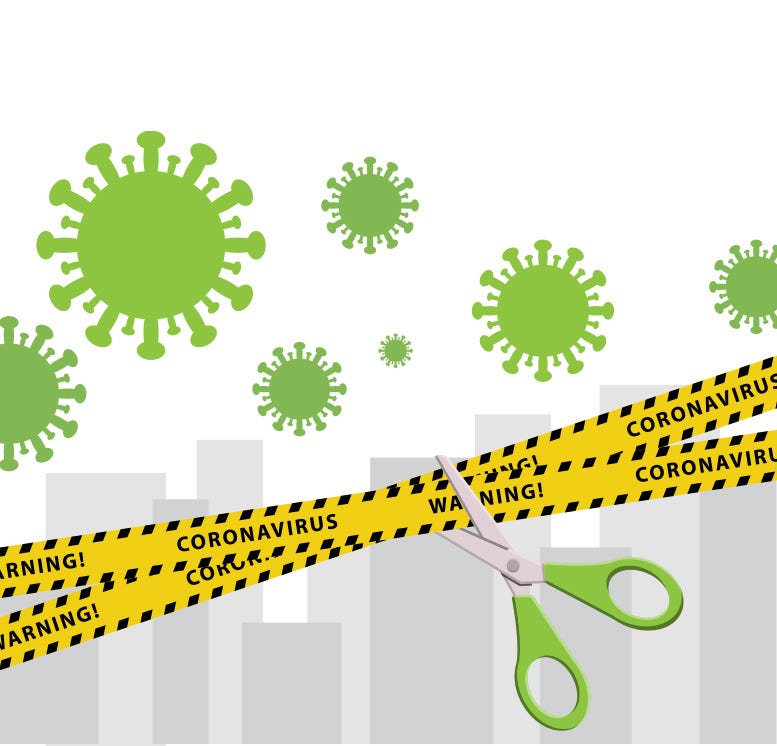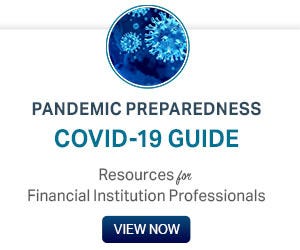Lockdowns are beginning to lift across the country and states begin to reopen. When returning to work after COVID-19, businesses are looking for ways to reopen as safely as possible for employees and clients. Financial institutions are no exception. Guidance from the Center for Disease Control (CDC) and the Occupational Safety and Health Administration (OSHA) will help financial institutions reopen safely. Following these recommendations will help alleviate employee concerns about resuming operations, lessen client fears about coming into the lobbies, and help mitigate the institution’s liability in the event that an employee or client contracts COVID-19.
When returning to work after COVID-19, it is important to understand how the disease transmits and infects. According to the CDC1, the following is helpful when understanding how the disease can be spread:
- Spread from person to person occurs when there is close contact (6 feet) with an infected person
- Person to person spread is thought to be transmitted in two ways:
- Symptomatic person (person who shows symptoms of illness) may cough or sneeze, releasing infected droplets that can be inhaled through the nose or mouth of people nearby
- Asymptomatic person (person who shows no symptoms) may speak and droplets can be released and inhaled through the nose or mouth
- The disease can also be transmitted by touching surfaces that are contaminated by COVID-19, then touching their face, specifically their nose or mouth
Due to this ease of transmissibility, employees of financial institutions have considerable risk of exposure to COVID-19. Frequent person to person contact, whether between clients and employees, or employees with each other, as well as handling cash and other items can increase the spread.
Lockdowns are beginning to lift across the country and states begin to reopen. When returning to work after COVID-19, businesses are looking for ways to reopen as safely as possible for employees and clients. Financial institutions are no exception. Guidance from the Center for Disease Control (CDC) and the Occupational Safety and Health Administration (OSHA) will help financial institutions reopen safely. Following these recommendations will help alleviate employee concerns about resuming operations, lessen client fears about coming into the lobbies, and help mitigate the institution’s liability in the event that an employee or client contracts COVID-19.

When returning to work after COVID-19, it is important to understand how the disease transmits and infects. According to the CDC1, the following is helpful when understanding how the disease can be spread:
- Spread from person to person occurs when there is close contact (6 feet) with an infected person
- Person to person spread is thought to be transmitted in two ways:
- Symptomatic person (person who shows symptoms of illness) may cough or sneeze, releasing infected droplets that can be inhaled through the nose or mouth of people nearby
- Asymptomatic person (person who shows no symptoms) may speak and droplets can be released and inhaled through the nose or mouth
- The disease can also be transmitted by touching surfaces that are contaminated by COVID-19, then touching their face, specifically their nose or mouth
Due to this ease of transmissibility, employees of financial institutions have considerable risk of exposure to COVID-19. Frequent person to person contact, whether between clients and employees, or employees with each other, as well as handling cash and other items can increase the spread.
Precautions to Consider When Returning to Work After COVID-19 Safer at Home Orders
As financial institutions prepare for returning to work after COVID-19, special precautions need to be made to help prevent the possible spread of infection. OSHA2 has added the following supplementary guidance.
Safe Work Practices When Returning to Work:
- Promote frequent hand washing and provide employees with a place to wash their hands
- Provide alcohol-based disinfectant containing at least 60% alcohol to all employees
- Encourage proper respiratory etiquette, such as covering a cough or sneeze
- Encourage the use of wearing masks
- Wipe down card terminals and pens between each customer
- Wipe down phones, keyboards, and other equipment as often as possible, but especially if it is a shared space with other employees
- Encourage employees who feel sick to stay home until they feel better
Administrative Controls:
- Encourage clients to still utilize ATMs whenever possible
- Reduce crowding in the facility by doing one or more of the following:
- Restrict the number of clients allowed inside at any point in time
- Specify hours dedicated to the vulnerable population
- Consider staggering shifts as much as possible
Physical Setup Controls:
- Use physical barriers to separate employees from clients when possible
- Create signage to instruct clients to remain 6 feet apart
- Provide a waiting area for customers that is at least 6 feet from employees when possible
The CDC has also provided a decision tool to aid workplaces in determining whether or not a business is prepared to reopen. It is important to use this tool and determine the most appropriate actions to protect workers and clients.
The CDC has recently issued further guidance on proper cleaning techniques to help prevent the spread of germs. The guidance suggests a three-step approach to proper cleaning:
- Develop your plan
- Determine what areas need to be cleaned and how often. Consider the type of surface. Areas such as teller stands, desks, and ATMs will need to be cleaned more frequently than other areas.
- Consider what resources are needed. Remember that availability of cleaning products may be scarce. Consider the protection of custodial staff and provide personal protective equipment (PPE) when necessary.
- If you need assistance in developing your plan, the flowchart on page 2 of the guidance helps in prioritizing areas most in need of frequent cleaning.
- Implement your plan
- Clean surfaces with soap and water prior to disinfecting.
- Utilize the appropriate disinfectant for the surface
- Follow all directions on the label of the disinfectant
- Maintain and revise your plan
- Revise your plan based on availability of products and equipment. Routinely disinfect the frequently touched surfaces, such as those listed above, at least once daily.
- Maintain the safe practices given in prior CDC guidances, such as handwashing guidelines and the use of face masks.
Flexibility in the Workplace
While business operations are returning to some semblance of “normal,” financial institutions must be flexible and understanding with their employees. Employers need to be aware that leave policies may need to be more flexible and understanding in light of the pandemic. OSHA recommends the following flexibilities3 once employees return to work after COVID-19:
- Ensure that sick leave policies are flexible and consistent with public health policies and that employees are aware of these policies
- Do not require a doctor’s note to validate an employee’s illness
- Maintain flexible policies that allow employees to stay home to care for a sick family member
- Be aware of employee concerns around leave, safety, and pay and be prepared to address and alleviate these concerns.
If you’re interested in learning even more, you can watch this webinar playback: COVID-19 New FMLA and Paid Leave Obligations.
When Returning to Work, Don’t Forget Client Safety
In addition to ensuring the health and safety of employees, financial institutions also need to ensure that clients feel secure in coming in. Many of the CDC and OSHA guidelines also protect clients. To maintain a safe space for clients, financial institutions can institute the following:
- Provide tissues for clients and no-touch trashcans
- Place touchless hand sanitizer stations in multiple locations to encourage hand hygiene
- Place signage throughout the facility that encourages hand hygiene
- Encourage non-contact methods of greeting between clients and employees
Following these suggestions will help clients feel at ease when coming into your institution.
Employer Liability When Financial Institutions Return to Work After COVID-19
These recommendations, as well as other guidance provided by the CDC, OSHA, and the National Institute of Health are non-binding in nature. However, OSHA’s General Duty Clause states that each employer “shall furnish to each of his employees employment and a place of employment which are free from recognized hazards that are causing or likely to cause death or serious physical harm to his employees.” Based on the nature of the virus, it would be difficult for a client or employee to prove that they became infected in the financial institution. However, if the institution disregards guidelines and a significant number of people become ill, a claim can be made for negligence.
If an employee contracts COVID-19, the liability of the institution is guided through state worker compensation law. Depending on the state, the employee may have to prove that they contracted the Coronavirus while at work.
In order to ensure employee health and safety, as well as limit liability, financial institutions should monitor and implement all federal, state, and local recommendations as outlined above.
As the country begins to reopen and financial institutions open their doors to clients again, employees and clients may be concerned for their health. It is important to follow federal and local guidelines to not only ensure the health of employees, but also ease the concerns of clients who wish to come into the institution.
Download the Guide
We are here to help you do your job efficiently, effectively and engagingly.
Keep Learning. Keep Growing. Stay Well.

About the Author
Rachel Davis
Product Manager at OnCourse Learning
Rachel Davis is the Product Manager of GRC and professional education for banks, credit unions, and non-bank financial services at OnCourse Learning. Rachel has worked in the financial services industry for 12 years and keeps up to date on financial industry hot topics. Rachel received her Bachelor of Arts in English Literature from Saint Louis University.

About the Author
Rachel Davis
Product Manager at OnCourse Learning
Rachel Davis is the Product Manager of GRC and professional education for banks, credit unions, and non-bank financial services at OnCourse Learning. Rachel has worked in the financial services industry for 12 years and keeps up to date on financial industry hot topics. Rachel received her Bachelor of Arts in English Literature from Saint Louis University.


Leave A Comment